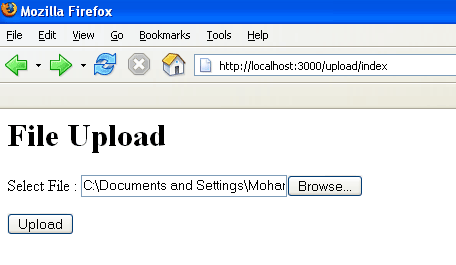File Uploading using Rails
You may have a requirement in which you want your site visitors to upload a file on your server. Rails makes it very easy to handle this requirement. Now we will proceed with a simple and small Rails project.
As usual, let’s start off with a new Rails application called upload. So let’s create basic structure of the application by using simple rails command.
C:\ruby> rails upload |
Now let’s decide where you would like to save your uploaded files. Assume this is data directory inside your public section. So create this directory and check the permissions.
C:\ruby> cd upload C:\ruby> mkdir upload\public\data |
Our next step will be as usual, to create controller and models, so let’s do that:
Creating Model:
Because this is not a database based application so we can keep name whatever is comfortable to us. Assume we have to create a DataFile model.
C:\ruby> ruby script/generate model DataFile
exists app/models/
exists test/unit/
exists test/fixtures/
create app/models/data_file.rb
create test/unit/data_file_test.rb
create test/fixtures/data_files.yml
create db/migrate
create db/migrate/001_create_data_files.rb
|
Now we will create a method called save in data_file.rb model file. This method will be called by the application controller.
class DataFile < ActiveRecord::Base
def self.save(upload)
name = upload['datafile'].original_filename
directory = "public/data"
# create the file path
path = File.join(directory, name)
# write the file
File.open(path, "wb") { |f| f.write(upload['datafile'].read) }
end
end
|
The above function will take CGI object upload and will extract uploaded file name using helper function original_filename and finally it will store uploaded file into “public/data” directory. You can call helper function content_type to know media type of the uploaded file.
Here File is a ruby object and join is a helper function will concatenate directory name alongwith file name and will return full file path.
Next, to open a file in write mode we are using open helper function provided by File object. Further we are reading data from the passed data file and writing into output file.
Creating Controller:
Now let’s create a controller for our upload project:
C:\ruby> ruby script/generate controller Upload
exists app/controllers/
exists app/helpers/
create app/views/upload
exists test/functional/
create app/controllers/upload_controller.rb
create test/functional/upload_controller_test.rb
create app/helpers/upload_helper.rb
|
Now we will create two controller functions first function index will call a view file to take user input and second function uploadFile takes file information from the user and passes it to the ‘DataFile’ model. We set the upload directory to the ‘uploads’ directory we created earlier “directory = ‘data’”.
class UploadController < ApplicationController
def index
render :file => 'app\views\upload\uploadfile.rhtml'
end
def uploadFile
post = DataFile.save(params[:upload])
render :text => "File has been uploaded successfully"
end
end
|
Here we are calling function defined in model file. The render function is being used to redirect to view file as well as to display a message.
Creating View:
Finally we will create a view file uploadfile.rhtml which we have mentioned in controller. Populate this file with the following code:
<h1>File Upload</h1>
<%= start_form_tag ({:action => 'uploadFile'},
:multipart => true) %>
<p><label for="upload_file">Select File</label> :
<%= file_field 'upload', 'datafile' %></p>
<%= submit_tag "Upload" %>
<%= end_form_tag %>
|
Here everything is same what we have explained in earlier chapters. Only new tag is file_field which will create a button to select a file from user’s computer.
By setting the multipart parameter to true, you ensure that your action properly passes along the binary data from the file.
Here, an important point to note is that we have assigned “uploadFile” as the method name in :action, which will be called when you click the Upload button.
This will show you a screen as follows:

Now you select a file and upload it, this file will be uploaded into app/public/data directory with the actual file name and a message will be displayed to you saying that “File has been uploaded successfully”.
NOTE: If a file with the same name already exists in your output directory then it will be over-written.
Files uploaded from Internet Explorer:
Internet Explorer includes the entire path of a file in the filename sent, so the original_filename routine will return something like:
C:\Documents and Files\user_name\Pictures\My File.jpg |
instead of just:
My File.jpg |
This is easily handled by File.basename, which strips out everything before the filename.
def sanitize_filename(file_name) # get only the filename, not the whole path (from IE) just_filename = File.basename(file_name) # replace all none alphanumeric, underscore or perioids # with underscore just_filename.sub(/[^\w\.\-]/,'_') end |
Deleting an existing File:
If you want to delete any existing file then its simple and need to write following code:
def cleanup
File.delete("#{RAILS_ROOT}/dirname/#{@filename}")
if File.exist?("#{RAILS_ROOT}/dirname/#{@filename}")
end
|
For a complete detail on File object, you need to go through Ruby Reference Manual.